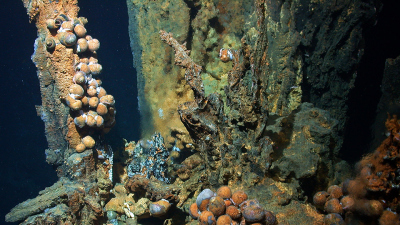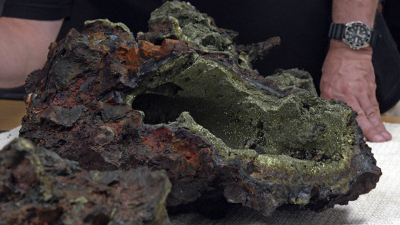- Home
- Discover
- Media Releases
- Media Releases 2023
- Deep Sea Mining
UN agency ISA postpones decision on deep-sea mining rules

The potential of deep-sea mining has gained recognition in recent decades, and its importance is often justified on economic grounds and by dwindling raw materials. The interest is primarily focused on manganese nodules, which grow on the ocean floor and are rich in metals like copper, nickel and cobalt. They occur most abundantly between water depths between 4,000 and 6,000 meters. So far, there are no rules for deep-sea mining, but this is only increasing interest. As a necessary consequence of the energy transition, industrial parties have expressed a need for rare earth metals, which are required for example in the production of rechargeable batteries.
By July 2023, the UN agency must establish a set of regulations for the extraction of raw materials in the deep sea. This should be applicable to deposits that lie outside the Exclusive Economic Zones of all countries and thus belong to the common heritage of mankind. Mineral resources found here are administered by the UN agency ISA based in Jamaica, as determined in the United Nations Convention on the Law of the Sea.
States call for a moratorium
The rush for the current ISA deliberation is founded on a two-year rule, which is controversial among researchers. In the summer of 2021, a commercial company and the Pacific Island Nation of Nauru applied to mine the deep sea. If there is no set of rules in place for mining within two years, applications would theoretically have to be provisionally confirmed. Environmental groups and some states, including Germany, and with the support of many ocean researchers, are calling for a moratorium on the mining of raw materials in the deep sea.
"Deep-sea mining does not offer viable solutions for supplying the raw materials that we need for the energy transition. There is no processing technology available that could be used to extract the desired metals from the manganese nodules. The massive sulfides, on the other hand, are high in copper, but the deposits are small, and with a worldwide annual demand of over 20 million tons of copper the known occurrences would only last a few months,” says Prof. Wolfgang Bach of MARUM.
Models and field research with MARUM participation
German researchers, including those from MARUM, have long been involved in environmental monitoring work. In cross-institute projects, they produce studies on deep-sea mining, for example in the Clarion-Clipperton Fracture Zone between Hawaii and Mexico, which is also the focus of current ISA deliberations. The research includes numerical modelling, in part on the effects of sediment turbulence on microbial communities on the ocean floor, and large-scale field experiments in cooperation with various scientific partners.
“All of the processes on the deep ocean floor are very slow, in part because the sediments settle very slowly in deep-sea regions with manganese nodules. In these areas, it often takes thousands of years for a centimeter of sediment to be deposited! We would therefore probably never see the recovery of an area around a mining site. The ocean floor is completely altered after the mining,” emphasizes Prof. Elda Miramontes García of MARUM.
After a scientific mining experiment in the Pacific off the coast of Peru, researchers returned more than two decades later. They wanted to evaluate the extent to which the marine environment had recovered. They found that the plough tracks were still clearly visible in the sediment, and microbial life had not returned to the level it was at before the field experiment. Mining attempts would also damage all surrounding structures, sometimes impacting species that we do not even know about yet.
Marine currents influence sediment motion
An additional aspect for the ecosystem of the deep sea is that the Clarion-Clipperton Zone in the eastern Pacific is a regions intensely affected by deep reaching eddies. “Our observations indicate that the deep currents and thus the potential mining conditions would be strongly influenced by the eddies passing through. The eddy activity, in turn, depends on the winds in the generation region off the west coast of the American continent, where it is influenced by weather and climate variability such as the El Niño/La Niña phenomenon,” explains Dr. Maren Walter of MARUM.
The currents at the sea floor are also an important factor in the (re-) deposition of sediments that would be stirred up during the potential mining. “Before we can confidently assess how much the variations in bottom currents will affect sediment suspension, and therefore ecosystems, I think it is irresponsible to begin mining the manganese nodules.”
Oasis of life in the deep sea
Besides manganese nodules, massive sulfides are also interesting objectives for deep-sea mining. They form around hydrothermal vents, where hot, metal-rich solutions come up from great depth to the seafloor where metal sulfides accumulate. Seafloor massive sulfides are often rich in copper and gold, but they are also home to rich ecosystems that form oases of life in the deep sea.
“There is no question that mining the sulfides would cause immeasurable damage to what are probably unique communities of the deep sea,” says Wolfgang Bach. The deep sea and the ocean floor comprise the largest contiguous habitat on Earth, but as such it has been relatively sparsely studied. Within the Cluster of Excellence “The Ocean Floor – Earth’s Uncharted Interface”, scientists at MARUM are working on deciphering the functions and importance of the deep sea.
At their current meeting, the ISA was not able to agree on a set of regulations for deep-sea mining. The next meeting is planned for July 2023.
Contact for inquiries:
Ulrike Prange
MARUM Media Relations
MARUM – Center for Marine Environmental Sciences, University of Bremen
Telephone: 0421-218 65540Email: [Bitte aktivieren Sie Javascript]
MARUM produces fundamental scientific knowledge about the role of the ocean and the seafloor in the total Earth system. The dynamics of the oceans and the seabed significantly impact the entire Earth system through the interaction of geological, physical, biological and chemical processes. These influence both the climate and the global carbon cycle, resulting in the creation of unique biological systems. MARUM is committed to fundamental and unbiased research in the interests of society, the marine environment, and in accordance with the sustainability goals of the United Nations. It publishes its quality-assured scientific data to make it publicly available. MARUM informs the public about new discoveries in the marine environment and provides practical knowledge through its dialogue with society. MARUM cooperation with companies and industrial partners is carried out in accordance with its goal of protecting the marine environment.



